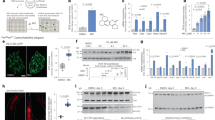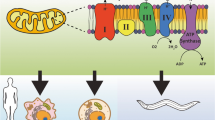Abstract
With the growth of aging population, there is increasing demand to develop strategy to improve the aging process and aging-related diseases. Benzimidazole and its derivatives are crucial heterocyclic backbone of many drugs and compounds with diverse therapeutic applications, including alleviation of aging-related diseases. Here, we investigate if the benzimidazole derivative n-butyl-[1H]-benzimidazol-2-amine (M084), a novel inhibitor of TRPC4 and TRPC5 channels and antidepressant, could affect the lifespan of Caenorhabditis elegans (C. elegans). Our results showed that M084 could extend the lifespan of C. elegans, delay age-related decline of phenotypes, and improve stress resistance. M084 could not extend the lifespan of the loss-of-function mutants of daf-16, daf-2, pdk-1, aak-2, clk-1, isp-1, sir-2.1, and skn-1. M084 could decrease the ATP level and increase the gene expression of mitochondrial unfolded protein response factors. Thus, M084 might inhibit the mitochondrial respiration, activate mitochondrial unfolded protein response and AMPK, recruite SIR-2.1 and SKN-1, and finally through the transcription factor DAF-16, delay the aging process of C. elegans. Our findings reveal the new pharmaceutical potential of benzimidazole derivatives and provide clue for developing novel anti-aging agents.






Similar content being viewed by others
References
Briguglio I, Piras S, Corona P, Gavini E, Nieddu M, Boatto G, Carta A (2015) Benzotriazole: an overview on its versatile biological behavior. Eur J Med Chem 97:612–648. doi:10.1016/j.ejmech.2014.09.089
Dupuy J, Alvinerie M, Menez C, Lespine A (2010) Interaction of anthelmintic drugs with P-glycoprotein in recombinant LLC-PK1-mdr1a cells. Chem Biol Interact 186:280–286. doi:10.1016/j.cbi.2010.05.013
Law EH, Badowski M, Hung YT, Weems K, Sanchez A, Lee TA (2016) Association between proton pump inhibitors and microscopic colitis: implications for practice and future research. Ann Pharmacother. doi:10.1177/1060028016673859
Yun J, Kim SY, Yoon KS, Shin H, Jeong HS, Chung H, Kim YH, Shin J, Cha HJ, Han KM, Hyeon S, Lee TH, Park HK, Kim HS (2016) P21 (Cdc42/Rac)-activated kinase 1 (pak1) is associated with cardiotoxicity induced by antihistamines. Arch Pharm Res. doi:10.1007/s12272-016-0840-7
Bopp RJ, Quay JF, Morris RM, Stucky JF 2nd, Miner DJ (1985) Liquid chromatographic analysis of enviradene, a new antiviral agent, in plasma and its application in bioavailability studies in the dog. J Pharm Sci 74:846–850
Belal TS, Mahrous MS, Abdel-Khalek MM, Daabees HG, Khamis MM (2014) Validated spectrofluorimetric determination of two pharmaceutical antihypertensive mixtures containing amlodipine besylate together with either candesartan cilexetil or telmisartan. Luminescence 29:893–900. doi:10.1002/bio.2638
Asekunowo PO, Haque RA, Razali MR, Budagumpi S (2015) Benzimidazole-based silver(I)-N-heterocyclic carbene complexes as anti-bacterials: synthesis, crystal structures and nucleic acids interaction studies. Appl Organomet Chem 29:126–137. doi:10.1002/aoc.3256
Chandrika NT, Shrestha SK, Ngo HX, Garneau-Tsodikova S (2016) Synthesis and investigation of novel benzimidazole derivatives as antifungal agents. Bioorg Med Chem 24:3680–3686. doi:10.1016/j.bmc.2016.06.010
Pan T, He X, Chen B, Chen H, Geng G, Luo H, Zhang H, Bai C (2015) Development of benzimidazole derivatives to inhibit HIV-1 replication through protecting APOBEC3G protein. Eur J Med Chem 95:500–513. doi:10.1016/j.ejmech.2015.03.050
Bukhari SN, Lauro G, Jantan I, Fei Chee C, Amjad MW, Bifulco G, Sher H, Abdullah I, Rahman NA (2016) Anti-inflammatory trends of new benzimidazole derivatives. Future Med Chem 8:1953–1967. doi:10.4155/fmc-2016-0062
Arora RK, Kaur N, Bansal Y, Bansal G (2014) Novel coumarin-benzimidazole derivatives as antioxidants and safer anti-inflammatory agents. Acta Pharm Sin B 4:368–375. doi:10.1016/j.apsb.2014.07.001
Bhrigu B, Siddiqui N, Pathak D, Alam MS, Ali R, Azad B (2012) Anticonvulsant evaluation of some newer benzimidazole derivatives: design and synthesis. Acta Pol Pharm 69:53–62
Shingalapur RV, Hosamani KM, Keri RS, Hugar MH (2010) Derivatives of benzimidazole pharmacophore: synthesis, anticonvulsant, antidiabetic and DNA cleavage studies. Eur J Med Chem 45:1753–1759. doi:10.1016/j.ejmech.2010.01.007
Iemura R, Hori M, Saito T, Ohtaka H (1989) Bioisosteric transformation of H1-antihistaminic benzimidazole derivatives. Chem Pharm Bull 37:2723–2726
Mochona B, Mazzio E, Gangapurum M, Mateeva N, Redda KK (2015) Synthesis of some benzimidazole derivatives bearing 1,3,4-Oxadiazole moiety as anticancer agents. Chem Sci Trans 4:534–540. doi:10.7598/cst2015.1029
Keri RS, Hiremathad A, Budagumpi S, Nagaraja BM (2015) Comprehensive review in current developments of benzimidazole-based medicinal chemistry. Chem Biol Drug Des 86:19–65. doi:10.1111/cbdd.12462
Zhu J, Wu CF, Li X, Wu GS, Xie S, Hu QN, Deng Z, Zhu MX, Luo HR, Hong X (2013) Synthesis, biological evaluation and molecular modeling of substituted 2-aminobenzimidazoles as novel inhibitors of acetylcholinesterase and butyrylcholinesterase. Bioorg Med Chem 21:4218–4224. doi:10.1016/j.bmc.2013.05.001
Zhu Y, Lu Y, Qu C, Miller M, Tian J, Thakur DP, Zhu J, Deng Z, Hu X, Wu M, McManus OB, Li M, Hong X, Zhu MX, Luo HR (2015) Identification and optimization of 2-aminobenzimidazole derivatives as novel inhibitors of TRPC4 and TRPC5 channels. Br J Pharmacol 172:3495–3509. doi:10.1111/bph.13140
Yang LP, Jiang FJ, Wu GS, Deng K, Wen M, Zhou X, Hong X, Zhu MX, Luo HR (2015) Acute treatment with a novel TRPC4/C5 channel inhibitor produces antidepressant and anxiolytic-like effects in mice. PLoS ONE 10:e0136255. doi:10.1371/journal.pone.0136255
Centers for Disease Control and Prevention (CDC) (2003) Trends in aging–United States and worldwide. MMWR Morb Mortal Wkly Rep 52:101–104,106
Barnes PM, Adams PF, Schiller JS (2003) Summary health statistics for the U.S. population: National health interview survey, 2001. Vital Health Stat 10:1–82
de Magalhaes JP, Wuttke D, Wood SH, Plank M, Vora C (2012) Genome-environment interactions that modulate aging: powerful targets for drug discovery. Pharmacol Rev 64:88–101. doi:10.1124/pr.110.004499
Butler RN, Miller RA, Perry D, Carnes BA, Williams TF, Cassel C, Brody J, Bernard MA, Partridge L, Kirkwood T, Martin GM, Olshansky SJ (2008) New model of health promotion and disease prevention for the 21st century. BMJ 337:a399. doi:10.1136/bmj.a399
Carmona JJ, Michan S (2016) Biology of healthy aging and longevity. Rev Invest Clin 68:7–16
Altintas O, Park S, Lee S-JV (2016) The role of insulin/IGF-1 signaling in the longevity of model invertebrates, C. elegans and D. melanogaster. BMB Rep 49:81–92. doi:10.5483/BMBRep.2016.49.2.261
Stiernagle T (2006) Maintenance of C. elegans. WormBook 1–11. doi: 10.1895/wormbook.1.101.1
Huang C, Xiong C, Kornfeld K (2004) Measurements of age-related changes of physiological processes that predict lifespan of Caenorhabditis elegans. Proc Natl Acad Sci USA 101:8084–8089. doi:10.1073/pnas.0400848101
Oh SI, Park JK, Park SK (2015) Lifespan extension and increased resistance to environmental stressors by N-Acetyl-L Cysteine in Caenorhabditis elegans. Clinics 70:380–386. doi:10.6061/clinics/2015(05)13
Winder Catherine L, Dunn Warwick B, Schuler Stephanie, Broadhurst David, Jarvis Roger, Stephens Gillian M, Goodacre R (2008) Global metabolic profiling of Escherichia coli cultures: an evaluation of methods for quenching and extraction of intracellular metabolites. Anal Chem 80:2939–2948
Wang X, Hu M, Feng J, Liu M, Hu JZ (2014) 1H NMR Metabolomics study of metastatic melanoma in C57BL/6 J mouse spleen. Metabolomics 10:1129–1144. doi:10.1007/s11306-014-0652-z
Hoogewijs D, Houthoofd K, Matthijssens F, Vandesompele J, Vanfleteren JR (2008) Selection and validation of a set of reliable reference genes for quantitative sod gene expression analysis in C. elegans. BMC Mol Biol 9:9. doi:10.1186/1471-2199-9-9
Herndon LA, Schmeissner PJ, Dudaronek JM, Brown PA, Listner KM, Sakano Y, Paupard MC, Hall DH, Driscoll M (2002) Stochastic and genetic factors influence tissue-specific decline in ageing C. elegans. Nature 419:808–814. doi:10.1038/nature01135
Kenyon CJ (2010) The genetics of ageing. Nature 464:504–512. doi:10.1038/nature08980
Yen K, Narasimhan SD, Tissenbaum HA (2011) DAF-16/Forkhead box O transcription factor: many paths to a single Fork(head) in the road. Antioxid Redox Signal 14:623–634
Ogg S, Paradis S, Gottlieb S, Patterson GI, Lee L, Tissenbaum HA, Ruvkun G (1997) The fork head transcription factor DAF-16 transduces insulin-like metabolic and longevity signals in C. elegans. Nature 389:994–999. doi:10.1038/40194
Aguilaniu H, Durieux J, Dillin A (2005) Metabolism, ubiquinone synthesis, and longevity. Genes Dev 19:2399–2406. doi:10.1101/gad.1366505
Feng JL, Bussiere F, Hekimi S (2001) Mitochondrial electron transport is a key determinant of life span in Caenorhabditis elegans. Dev Cell 1:633–644. doi:10.1016/S1534-5807(01)00071-5
Pena S, Sherman T, Brookes PS, Nehrke K (2016) The mitochondrial unfolded protein response protects against Anoxia in Caenorhabditis elegans. PLoS ONE 11:e0159989. doi:10.1371/journal.pone.0159989
Lopez-Lluch G, Navas P (2016) Calorie restriction as an intervention in ageing. J Physiol 594:2043–2060. doi:10.1113/jp270543
Edwards C, Canfield J, Copes N, Brito A, Rehan M, Lipps D, Brunquell J, Westerheide SD, Bradshaw PC (2015) Mechanisms of amino acid-mediated lifespan extension in Caenorhabditis elegans. BMC Genet 16:1. doi:10.1186/s12863-015-0167-2
Mair W, Dillin A (2008) Aging and survival: the genetics of life span extension by dietary restriction. Annu Rev Biochem 77:727–754. doi:10.1146/annurev.biochem.77.061206.171059
Berdichevsky A, Viswanathan M, Horvitz HR, Guarente L (2006) C. elegans SIR-2.1 interacts with 14-3-3 proteins to activate DAF-16 and extend life span. Cell 125:1165–1177. doi:10.1016/j.cell.2006.04.036
Blackwell TK, Steinbaugh MJ, Hourihan JM, Ewald CY, Isik M (2015) SKN-1/Nrf, stress responses, and aging in Caenorhabditis elegans. Free Radic Biol Med 88:290–301. doi:10.1016/j.freeradbiomed.2015.06.008
Tullet JMA, Hertweck M, An JH, Baker J, Hwang JY, Liu S, Oliveira RP, Baumeister R, Blackwell TK (2008) Direct inhibition of the longevity-promoting factor SKN-1 by insulin-like signaling in C. elegans. Cell 132:1025–1038. doi:10.1016/j.cell.2008.01.030
Spasov AA, Yozhitsa IN, Bugaeva LI, Anisimova VA (1998) Benzimidazole derivatives: spectrum of pharmacological activity and toxicological properties. Pharm Chem J 33:6–17
Biron KK, Harvey RJ, Chamberlain SC, Good SS, Smith AA, Davis MG, Talarico CL, Miller WH, Ferris R, Dornsife RE, Stanat SC, Drach JC, Townsend LB, Koszalka GW (2002) Potent and selective inhibition of human Cytomegalovirus replication by 1263W94, a benzimidazole l-Riboside with a unique mode of action. Antimicrob Agents Chemother 46:2365–2372. doi:10.1128/aac.46.8.2365-2372.2002
Okamura N, Suemoto T, Furumoto S, Suzuki M, Shimadzu H, Akatsu H, Yamamoto T, Fujiwara H, Nemoto M, Maruyama M, Arai H, Yanai K, Sawada T, Kudo Y (2005) Quinoline and benzimidazole derivatives: candidate probes for in vivo imaging of tau pathology in Alzheimer’s disease. J Neurosci 25:10857–10862. doi:10.1523/JNEUROSCI.1738-05.2005
Acknowledgements
C. elegans strains were provided by the CGC, which is funded by NIH Office of Research Infrastructure Programs (P40 OD010440). This work was partially supported by the Natural Science Foundation of China (Grant Nos. 81671405 and 81370453) and Natural Science Foundation of Yunnan province (Grant Nos. 2013FA045 and 2015FB172).
Author information
Authors and Affiliations
Corresponding author
Electronic supplementary material
Below is the link to the electronic supplementary material.
Rights and permissions
About this article
Cite this article
Ding, AJ., Wu, GS., Tang, B. et al. Benzimidazole derivative M084 extends the lifespan of Caenorhabditis elegans in a DAF-16/FOXO-dependent way. Mol Cell Biochem 426, 101–109 (2017). https://doi.org/10.1007/s11010-016-2884-x
Received:
Accepted:
Published:
Issue Date:
DOI: https://doi.org/10.1007/s11010-016-2884-x




